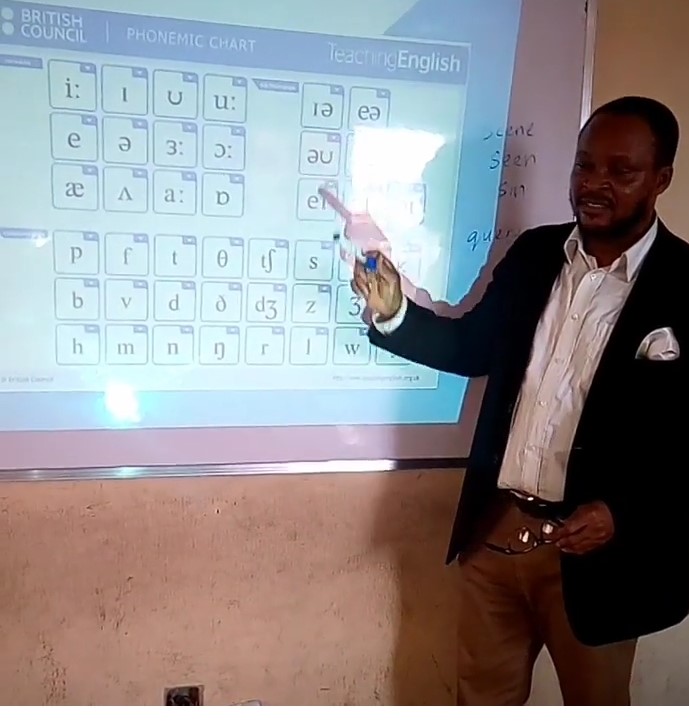The International Phonetic Alphabet (IPA) is an invaluable tool when teaching English pronunciation and listening, but many teachers struggle with how to teach the IPA chart. We’ll answer the question, “What is the IPA in ESL and EFL?” and offer some simple strategies and tips for teachers to effectively use the IPA chart in their classrooms.
What is the IPA chart in English language teaching?
It is a speech sound transcription.
The IPA chart is a system of speech sound transcription. This means that it is a way of taking what is spoken in a language and transcribing or writing what sounds were produced.
In the IPA, one symbol equals one sound. There aren’t combination symbols like there are combination letters/sounds in written English (think letter combinations like “th” or “ou”). Instead, each symbol represents a single sound, or what linguists call a phoneme. This really helps students to understand ESL pronunciation and phonics in a clear and direct manner.
It is non-language specific.
The IPA was designed to be non-language specific. Linguists wanted it to be international and represent sounds from any and every language. Therefore, many symbols on the IPA chart have no function in standard English because the language doesn’t use those sounds. Every language uses only a set of symbols in the IPA, never all of them.
For example, French doesn’t have a “th” sound; however, it does have a “u” sound (somewhere between the English “u” and “ew”), which doesn’t exist in English. The IPA has a symbol for both sounds, and even two symbols for the different “th” sounds – yes, there are two!

It can be used for English language teaching.
The IPA is particularly useful for teaching English. This is because English is a language where the spelling doesn’t always make sense. The letters don’t match the sounds they supposedly make. From words (like “know”) with silent letters to words (like “colonel”) adopted from other languages, English’s writing system is less than reliable for sounding out words. The phonemes don’t match the letters. When teaching IPA to ESL students, the chart shows exactly what is being said without the distractions of silent letters or combination vowels.
In a BridgeUniverse Expert Series webinar that discussed using the IPA chart when teaching English pronunciation, Michael Berman, Chief Education Officer of Pro Lingua Learning and Professor of ESL at Montgomery College, noted, “We need a way of describing what we are saying… The IPA helps ground us and make sure we’re talking apples to apples.”
-
An important note before teaching the IPA for ESL/EFL: The symbols you use will change depending on whether you are teaching American English, British English, etc. You may be teaching English as a global language, in which case, choose whichever pronunciation is closer to the English you personally use in class. Be sure to point this out to your students.
Below is a clip, from the aforementioned BridgeUniverse Expert Series webinar, that summarizes the IPA. You can watch the full webinar here.
How do you teach the IPA phonetic chart?
Essentially, the easiest way to tackle teaching the IPA for English pronunciation is by using it to distinguish different phonemes. Even if students aren’t totally familiar with the chart, you can write the symbol for a particular sound on the board or use it in an activity. Let’s take a look at some ways to do this.
Incorporate the IPA into daily lessons.
To familiarize students with the IPA, you need to repeatedly expose them to the symbols. A great way to introduce a few symbols initially is by starting with the -ed endings: /t/, /id/, and /d/. Give students a list of words with -ed endings like worked, helped, wanted, wandered, etc. Ask them to say the words aloud in small groups or pairs and decide which IPA symbol corresponds to each word. Go over the answers as a whole class to see if students were able to correctly distinguish the three different sounds that the -ed ending can make.
Over time, you can build on students’ knowledge of which symbols represent which phonemes. Introducing the IPA chart for ESL students in bite-sized chunks rather than as one gigantic chart upfront can help them internalize the information and feel less overwhelmed.
Use a phonetic chart or pronunciation app.
Another great way of teaching the IPA chart for language learners is to use online tools for teaching English pronunciation. Apps like ELSA Speak and Sensay work with AI-powered speech recognition to analyze students’ pronunciation and offer feedback. Whether you assign students activities via a pronunciation app as homework or let them use these tools in class, they offer a fun way to study pronunciation a little each day.
Many of these pronunciation apps also include a digital version of the phonetic chart. Students can use this as a tool for phonetic transcription activities. It can also help them get familiar with each of the sounds or check any symbols they aren’t sure about. Consider letting students keep their phones on hand during class in order to refer back to their charts throughout the lesson.
Teach your students to speak with confidence with the
Micro-credential in Teaching English Pronunciation
Get CertifiedTeach pronunciation, not symbols.
It’s important to not make the class’s main objective to learn the IPA chart, but instead, to use the IPA chart as a tool for better pronunciation and listening.
In the BridgeUniverse Expert Series webinar referenced earlier, Berman further remarked, “We want our students to speak in clear, understandable English… not necessarily remember a bunch of symbols.”
Keeping the ultimate learning objective (correct English pronunciation) in mind will help guide your lesson plans and activities. It will also remind students why they are using the IPA chart and how this powerful tool can help them communicate effectively in the real world.
To learn more strategies for teaching pronunciation and using the IPA chart, take Bridge’s Micro-credential course in Teaching English Pronunciation. The below infographic, from the course, offers tips for handling error correction when it comes to pronunciation.
How can I use the IPA chart to improve my students’ pronunciation?
Use the IPA chart to tackle tricky vowels or other problematic sounds.
The IPA chart’s symbols allow a teacher to isolate a problem sound for a student and show them what they are saying versus what the word should sound like.
This is especially helpful with English vowels, which tend to make the schwa sound when unstressed. For example, with the IPA, you can show the student a word like “photograph” and point out that the second “o” is unstressed and so sounds like “uh” or /ə/. You can compare this to the word “photographer,” which switches the stress from the first to the second syllable.
Diphthongs, a sound formed by combining two vowels, can also sometimes present problems for language learners. Incorporating transcription activities using the IPA chart can help students when pronouncing these trickier phonemes.
Check out why you should teach your students a variety of accents and dialects.
Combine the IPA chart with games and fun activities.
Does the idea of teaching the IPA to ESL students make you think of a dull class that entails memorizing a bunch of symbols? It shouldn’t! As with all English topics, if you want students to take an interest in the lesson, you need to make it engaging and fun.
In the BridgeUniverse Expert Series webinar on utilizing the IPA chart, Berman suggested using games when teaching the IPA phonetic chart. His go-to activity is Seven Strikes, where students compete in teams to phonetically transcribe a word that they hear. The teacher should write the number of blanks needed for the transcription on the board. Groups can raise their hands after a minute to check if their transcription is correct, but if it’s wrong, they gain a strike. The first group to seven strikes loses. The game is particularly great for going over vocabulary you’ve already taught in class.
You can listen to Berman explain how to play Seven Strikes in the following video. Or, watch the full BridgeUniverse Expert Series webinar on the IPA chart – and access a growing library of webinars on other diverse topics – here!
Another easy game is Superphonic Bingo, where the teacher calls out a word, and the students match it with a word written in phonetic script on their Bingo card.
A third fun activity that you can use is having students transcribe a short poem. Doctor Seuss’ poems work particularly well for this, as they repeat the same sounds quite often. Keep in mind, however, that this activity requires your students to already be familiar with the IPA.
Utilize the IPA chart to point out sounds that don’t occur in your student’s native language (L1).
Having a deeper knowledge of a student’s first language can assist with understanding their accents and pronunciation issues. For example, a student whose first language is German may have trouble hearing the difference between the “th” sounds in “thick” [θɪk] and “these” [ðiːz]. This is because these sounds don’t exist in German. French students, on the other hand, tend to confuse the short “i” sound, as in “it” [ɪt], with the long “e” sound, as in “eat” [iːt]. This is because the short “i” sound [ɪ] doesn’t occur in French.
With IPA in ESL, you can visually show students how they’re pronouncing certain sounds versus how they should be pronouncing them. Using the IPA symbols to introduce sounds that might be new to your students (i.e., that don’t exist in their L1) can be invaluable for helping them to understand how to pronounce important phonemes.
Any teacher can use the IPA chart to help students differentiate between phonemes and master English sounds. When used correctly, this powerful tool can have a lasting impact on boosting students’ pronunciation skills. This last piece of advice comes from Berman: “If you engage your students, they will learn.”







